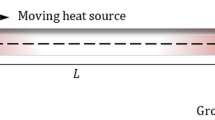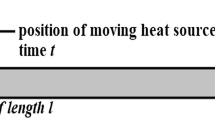Abstract
Based on the generalized thermoelastic theory, the physical changes of a finite length rod, which is composed of one-dimensional (1D) hexagonal piezoelectric quasicrystals (PQCs) fixed on both sides and subjected to a moving heat source, are studied. The numerical solutions are obtained using the Laplace transform and its numerical inversion. The effects of displacement, stress, temperature and electric potential on velocity of moving heat source and time were studied. It can be seen from the distribution that the temperature, displacement, electric potential and stress of the rod all increase when the time increases, while the influence of the heat source velocity is opposite.







Similar content being viewed by others
References
Shechtman, D., Blech, I., Gratias, D., Cahn, J.W.: Metallic phase with long-range orientational order and no translational symmetry. Phys. Rev. Lett. 53(20), 1951–1953 (1984)
Levine, D., Steinhardt, P.J.: Quasicrystals. J. Non-cryst. Solids 75(1–3), 85–89 (1985)
Louzguine-Luzgin, D.V., Inoue, A.: Formation and properties of quasicrystals. Annu. Rev. Mater. Res. 38(1), 403–423 (2008)
Li, L.H., Liu, G.T.: Stroh formalism for icosahedral quasicrystal and its application. Phys. Lett. A 376(8), 987–990 (2012)
Li, X.F.: Elastohydrodynamic problems in quasicrystal elasticity theory and wave propagation. Philos. Mag. 93(13), 1500–1519 (2013)
Li, X.Y., Li, P.D., Wu, T.H., Shi, M.X., Zhu, Z.W.: Three-dimensional fundamental solutions for one-dimensional hexagonal quasicrystal with piezoelectric effect. Phys. Lett. A 378(10), 826–834 (2014)
Fan, T.Y.: Mathematical Theory of Elasticity of Quasicrystals and its Applications. Science Press, Beijing (2011)
Hu, C.Z., Wang, R.H., Ding, D.H., Yang, W.G.: Piezoelectric effects in quasicrystals. Phys. Rev. B 56(5), 2463–2468 (1997)
Altay, G., Dömeci, M.C.: On the fundamental equations of piezoelasticity of quasicrystal media. Int. J. Solids Struct. 49(23–24), 3255–3262 (2012)
Guo, J.H., Zhang, Z.Y., Xing, Y.M.: Antiplane analysis for an elliptical inclusion in 1D hexagonal piezoelectric quasicrystal composites. Philos. Mag. 96(4), 349–369 (2016)
Zhou, Y.B., Li, X.F.: Two collinear mode-\(III\) cracks in one-dimensional hexagonal piezoelectric quasicrystal strip. Eng. Fract. Mech 189, 133–147 (2017)
Zhou, Y.B., Li, X.F.: A Yoffe-type moving crack in one-dimensional hexagonal piezoelectric quasicrystals. Appl. Math. Model. 65, 148–163 (2019)
Zhou, Y.B., Li, X.F.: Elasto-hydrodynamics of quasicrystals with a crack under sudden impacts. Philos. Mag. Lett. 1–18 (2019)
Zhao, M.H., Dang, H.Y., Fan, C.Y., Chen, Z.T.: Analysis of a three-dimensional arbitrarily shaped interface crack in a one-dimensional hexagonal thermo-electro-elastic quasicrystal bi-material. Part 1: theoretical solution. Eng. Fract. Mech. 179, 59–78 (2017)
Dang, H.Y., Zhao, M.H., Fan, C.Y., Chen, Z.T.: Analysis of a three-dimensional arbitrarily shaped interface crack in a one-dimensional hexagonal thermo-electro-elastic quasicrystal bi-material. Part 2: numerical method. Eng. Fract. Mech. 180, 268–281 (2017)
Sun, T.Y., Guo, J.H., Zhan, X.Y.: Static deformation of a multilayered one-dimensional hexagonal quasicrystal plate with piezoelectric effect. Appl. Math. Mech. 39(3), 335–352 (2018)
Zhou, Y.B., Li, X.F.: Exact solution of two collinear cracks normal to the boundaries of a 1D layered hexagonal piezoelectric quasicrystal. Philos. Mag. 98(19), 1780–1798 (2018)
Suo, Y.R., Zhou, Y.B., Liu, G.T.: Effect of T-stress on the fracture in an infinite two-dimensional decagonal quasicrystals of a cruciform crack with unequal arms. Int. J. Solids Struct. 232, 111181 (2021)
Zhao, Z.N., Guo, J.H.: Surface effects on a mode-\(III\) reinforced nano-elliptical hole embedded in one-dimensional hexagonal piezoelectric quasicrystals. Appl. Math. Mech. 42(5), 625–640 (2021)
Cheng, J.X., Liu, B.J., Huang, X.Z., Li, Z.X.: Anti-plane fracture analysis of 1D hexagonal piezoelectric quasicrystals with the effects of damage due to materials degradation. Theor. Appl. Fract. Mech. 113, 102939 (2021)
Huang, R.K., Ding, S.H., Zhang, X., Li, X.: Frictional contact problem of a rigid charged indenter on two dimensional hexagonal piezoelectric quasicrystals coating. Philos. Mag. 101(19), 2123–2156 (2021)
Tzou, D.Y.: The generalized lagging response in small-scale and high-rate heating. Int. J. Heat Mass Transf. 38(17), 3231–3240 (1995)
Tzou, D.Y.: A unified field approach for heat conduction from macro- to micro-scales. J. Heat Transf. 117(1), 8–16 (1995)
Roy Choudhuri, S.K.: On A Thermoelastic Three-Phase-Lag Model. J Therm Stress 30(3), 231–238 (2007)
Guo, Z.Y., Hou, Q.W.: On a thermoelastic three-phase-lag model. J. Heat Transf. 132(7), 072403 (2010)
Lord, H.W., Shulman, Y.: A generalized dynamical theory of thermoelasticity. J. Mech. Phys. Solids 15(5), 299–309 (1967)
Green, A.E., Lindsay, K.A.: Thermoelasticity. J. Elast. 2(1), 1–7 (1972)
Green, A.E., Naghdi, P.M.: Thermoelasticity without energy dissipation. J. Elast. 31(3), 189–208 (1993)
Hetnarski, R.B., Ignacza, J.: Greneralized thermoelasticity. J. Therm. Stress. 22(4–5), 451–476 (1999)
Abbas, I.A., Zenkour, A.M.: Two-temperature generalized thermoelastic interaction in an infinite fiber-reinforced anisotropic plate containing a circular cavity with two relaxation Times. J. Comput. Theor. Nanosci. 11(2), 331–338 (2014)
Li, X.Y., Li, P.D.: Three-dimensional thermo-elastic general solutions of one-dimensional hexagonal quasi-crystal and fundamental solutions. Phys. Lett. A 376(26–27), 2004–2009 (2012)
Li, X.Y., Wang, T., Zheng, R.F., Kang, G.Z.: Fundamental thermo-electro-elastic solutions for 1D hexagonal QC. Z. Angew. Math. Mech. 95(5), 457–468 (2013)
Yang, L.Z., Li, Y., Gao, Y., Pan, E.N.: Three-dimensional exact thermo-elastic analysis of multilayered two-dimensional quasicrystal nanoplates. Appl. Math. Model. 63, 203–218 (2018)
Chen, Z.T., Akbarzadeh, A.: Advanced Thermal Stress Analysis of Smart Materials and Structures. Springer International Publishing, Berlin (2020)
Li, C.L., Liu, Y.Y.: The physical property tensors of one-dimensional quasicrystals. Chin. Phys. 13(6), 924–931 (2004)
Rochal, S.B., Lorman, V.L.: Anisotropy of acoustic-phonon properties of an icosahedral quasicrystal at high temperature due to phonon-phason coupling. Phys. Rev. B Condens. 62(2), 874–879 (2000)
Ding, D.H., Yang, W.G., Hu, C.Z., Wang, R.H.: Generalized elasticity theory of quasicrystals. Phys. Rev. B 48(10), 7003–7010 (1993)
Li, X.F., Xie, L.Y., Fan, T.Y.: Elasticity and dislocations in quasicrystals with 18-fold symmetry. Phys. Rev. A 377(39), 2810–2814 (2013)
Hu, C.Z., Wang, R.H., Ding, D.H.: Symmetry groups, physical property tensors, elasticity and dislocations in quasicrystals. Rep. Prog. Phys. 63(2000), 1–39 (2000)
Fan, T.Y., Li, X.F., Sun, Y.F.: A moving screw dislocation in a one-dimensional hexagonal quasicrystal. Acta Phys. Sin-Ch Ed. 8(4), 288–295 (1999)
Babaei, M.H., Chen, Z.T.: Dynamic response of a thermopiezoelectric rod due to a moving heat source. Smart Mater. Struct. 18(2), 025003 (2009)
Durbin, F.: Numerical inversion of Laplace transforms: an efficient improvement to Dubner and Abate’s method. Comput. J. 17(4), 371–376 (1974)
Honig, G., Hirdes, U.: A method for the numerical inversion of Laplace transforms. J. Comput. Appl. Math. 10(1), 113–132 (1984)
He, T.H., Cao, L., Li, S.R.: Dynamic response of a piezoelectric rod with thermal relaxation. J. Sound Vib. 306(3–5), 897–907 (2007)
Acknowledgements
This work was supported by the National Natural Science Foundation of China (No.11962026), the Natural Science Foundation of Inner Mongolia China (No. 2020LH01011), the Talent Development Fund Project of Inner Mongolia (No. 5909002123) and the Fundamental Research Funds for the Inner Mongolia Normal University (No. 2022JBQN076).
Author information
Authors and Affiliations
Corresponding author
Ethics declarations
Conflict of interest
No potential conflict of interest was reported by the author(s).
Additional information
Publisher's Note
Springer Nature remains neutral with regard to jurisdictional claims in published maps and institutional affiliations.
Appendix A
Appendix A
The constants appearing in Eqs. (29)–(32) are
The constants appearing in Eq. (40) are
The constants appearing in Eq. (45) are
The Matrices appearing in Eq. (40) are
where \(\Delta _{i}=d_{i}\left( \delta _{10}+\delta _{20}\gamma _{i}\right) ,\Lambda _{i}=d_{i}\left( \delta _{1\,L}+\delta _{2\,L}\gamma _{i}\right) (i=1,2,3,4),\Delta _{5}=d_{5}\chi \left( \delta _{20}\frac{s}{v}-\delta _{10}\right) ,\Lambda _{5}=d_{5}\chi \left( \delta _{2\,L}\frac{s}{v}-\delta _{1\,L}\right) .\)
Rights and permissions
Springer Nature or its licensor (e.g. a society or other partner) holds exclusive rights to this article under a publishing agreement with the author(s) or other rightsholder(s); author self-archiving of the accepted manuscript version of this article is solely governed by the terms of such publishing agreement and applicable law.
About this article
Cite this article
Li, Y., Zhou, Y. Dynamic response of a piezoelectric quasicrystal rod with the generalized thermoelasticity. Acta Mech 235, 323–335 (2024). https://doi.org/10.1007/s00707-023-03747-4
Received:
Revised:
Accepted:
Published:
Issue Date:
DOI: https://doi.org/10.1007/s00707-023-03747-4




